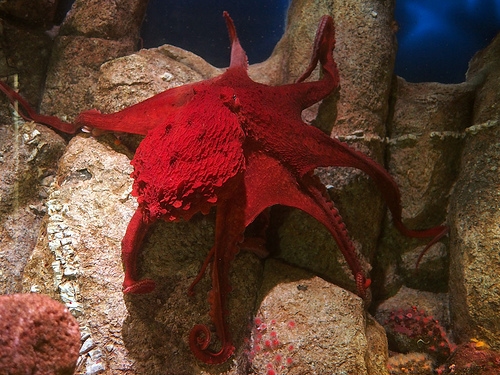
Otherwise, the Pygmy octopus requires similar care to any other member of its species. I suggest a rocky system with caves and crevices that the octopus can use to rest and prepare its ambushing tactics. So, this creature’s tank layout should comprise numerous hiding areas. You will see this small creature cuddling in the smallest spaces, including empty clamshells, whenever it feels threatened. Because of that, the Pygmy octopus has developed a unique hiding behavior. Much less predators specialized in eating octopi.

Given its small size, this cephalopod has difficulties with natural predation since it can’t use its size to impress anyone. These are tiny measurements compared to other species of octopi you may be used to. This little creature can only grow up to 2 inches wide, with tentacles only measuring up to 4 inches.

The Atlantic Pygmy octopus showcases a unique appearance and a matching personality. This will keep the octopus busy and entertained, which is great considering that octopi can get bored fast. You should feed the octopus once per day, preferably live food that would activate the creature’s hunting instincts. The ideal tank conditions include water temperature between 74 to 78 F, a rocky layout, and low lighting. This creature is powerful, aggressive, uses camouflage to hunt, and can lose limbs when threatened. You should expect your octopus to grow up to 12-14 inches and live around 8-12 months, although its lifespan will vary.Īside from that, everything about the common octopus falls in line with all species. Fortunately, you won’t have to deal with such a monstrous specimen since octopi rarely, if ever, reach these sizes in captivity. The common octopus can grow up to 36 inches in the wild and weigh up to 22 pounds. Strictly speaking, this is a must, as you can’t place it in any specific category. The common octopus is as…common as they come, yet not without its charm. Common Octopusīulbous eyes, large head, 8 tentacles, and a soft and flexible body. With that said, you have 6 popular octopi that you can keep as tank pets: 1. Always secure your tank properly to prevent this aquatic Houdini from making its grand escape. A 10-15-inch-wide octopus is also capable of squeezing its body through a 1-inch opening. They can climb the tank’s walls with ease and even push the tank’s lid to get out. Secure the tank – The octopus’s tentacles are very sensitive and powerful at the same time.Keep the tank in a darker room with some moderate environmental lighting and plenty of shade. Avoid light – The octopus doesn’t live with UV lighting.The octopus loves to move around the rocks and find cover from sunlight in shadier areas. Have plenty of rocks – You can have a reef structure without the corals or simply a rocky system with caves here and there.Some core things to keep in mind about their tank setup include: You only need to consider the animal’s basic requirements and make sure it has all the necessary conditions to remain comfortable and healthy in its habitat.Īll octopi are ambush predators that display amazing camouflaging capabilities. While it may sound intimidating, keeping and caring for a pet octopus isn’t too difficult. Now, let’s look at some good octopi species that you can keep as pets. These animals are particularly aggressive towards their own and will resort to murder and cannibalism if you force them to live together. They have no patience for any tank mate and have no social instincts. Very aggressive – You cannot keep more than 1 octopus in the same tank.No matter how large their bodies are, they can always squeeze it through crevices and holes as big as the octopus’s eye. Escape artists – The octopus is highly intelligent and will escape even from seemingly secured habitats.In this sense, we have 59 to 72 F for the California two-spot octopus, 74 to 76 for the Caribbean dwarf octopus, and 60 to 65 F for the East Pacific red octopus.



 0 kommentar(er)
0 kommentar(er)
